MXA RACE TEST: THE REAL TEST OF THE 2019 HUSQVARNA FC250

Q: FIRST AND FOREMOST, IS THE 2019 HUSQVARNA FC250 BETTER THAN THE 2018 FC250?
A: The 2019 Husqvarna has some things that are better than the 2018 model and some things that are up for debate. The 250cc four-stroke power plant is identical to last year’s engine, save for some internal upgrades for durability. The bulk of changes were made to the chassis and suspension components. Overall, this is a really good bike, with the caveat that it feels more like a KTM than any Husky, since the two brands were blended in 2013.
Q: WHAT CHANGES WERE MADE TO THE 2019 HUSQVARNA FC250 FOR 2019?
A: Husqvarnas roll off the same assembly line as KTMs in Mattighofen, Austria, and share the same basic platform (such as the engine, chassis, wheels and suspension), but the two brands strive to have their own personalities. For 2019, it is the plastic parts (subframe and bodywork) that most notably separate the Husky from the KTM, but here is a complete list of changes that differentiate the 2019 Husqvarna FC250 from the 2018 model.
(1) Bodywork. The bodywork has been seriously updated. The number plate side panels are narrower, although for some reason they are divided into two separate pieces. We don’t know what the designer’s motivation was, because with the gap between the top and bottom of the side panels, the numbers never match perfectly. The new radiator shrouds are more shapely, higher up and better tucked in. The front number plate has a yellow plastic protector under it to protect the bottom triple clamp from roost—but the yellow plastic extension only protects the top half of the bottom triple clamps. The seat has more foam in the middle and a rounder shape to it. More foam is needed, as many riders complained about hitting the subframe when seat bouncing.
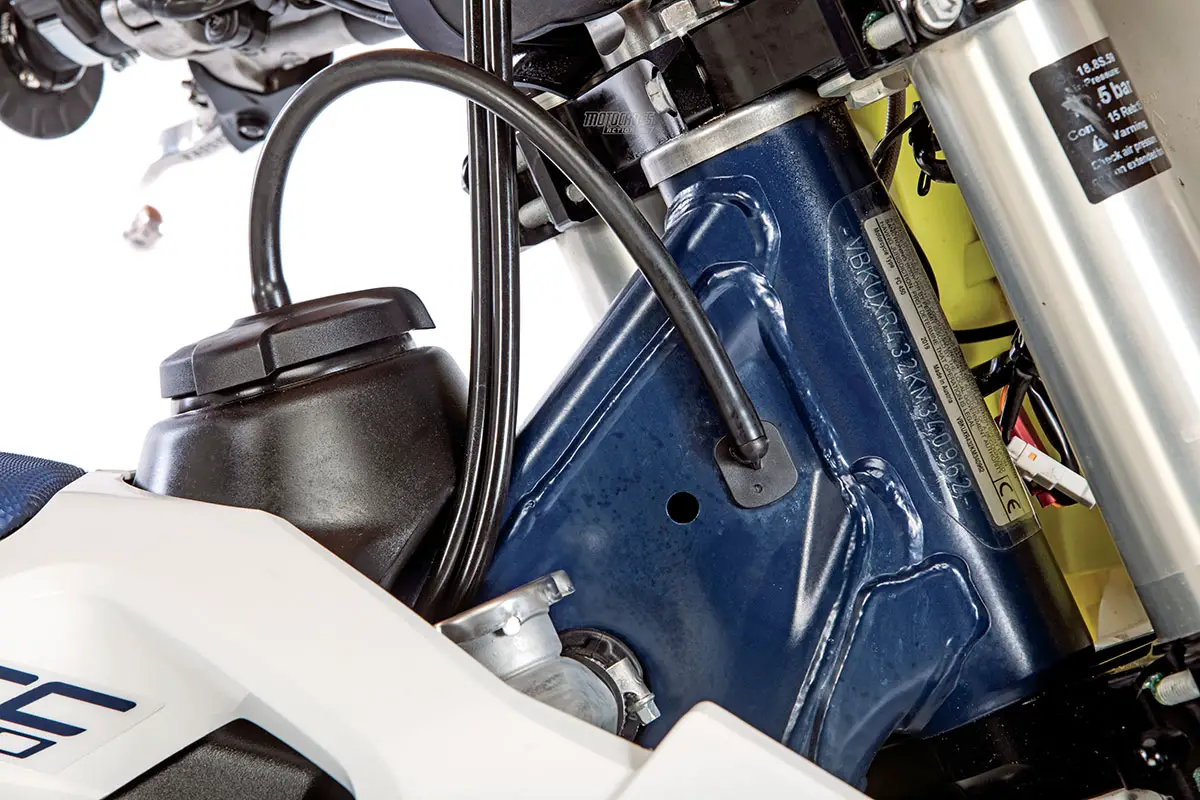
The most significant frame mods are done to the portion of the frame below the gas cap.
(2) Frame. The geometry of the frame is the same as last year’s chassis; however, the frame was made 10 percent stiffer torsionally and 2 percent stiffer longitudinally. This was achieved by increasing the diameter of the frame’s cross brace tube and redesigning the head tube gusseting. Most MXA test riders liked the flex of the 2018 FC250 frame over the more rigid 2019 frame. The new frame is not as plush when hitting bumps and landing from jumps. It is like having a harsh spot in your suspension. The plus of the 2019 FC250’s stiff frame is that the bike corners with more precision. Additionally, we preferred the white frame paint over the new dull blue color.
(3) Clutch. The FC250 gets a new version of the FC450’s Belleville washer-style clutch. In fact, the entire 2019 Husky clutch lineup has switched to diaphragm clutch springs. The clutch design varies with the Husky models. The FC450 four-stroke and TC250 two-stroke both have the DDS (damped diaphragm steel) clutch, while the FC350, FC250 and TC125/150 have a DS (diaphragm steel) clutch. What’s the difference between DDS and DS? The DDS clutch has six rubber dampers that sit inside the inner clutch hub to lessen the strain from the powerplant. The DS clutch doesn’t have the rubber dampers because Husqvarna’s engineers don’t feel that the lower power output of the smaller engines needs the cush hub dampers.
(4) Subframe. The carbon composite (a fancy word for plastic) subframe is now constructed from two pieces rather than three, allowing Husky to save weight while making the sub-frame stiffer. As was the case last year, the Husky subframe sits lower than the KTM subframe, lowering the FC250 by more than a 1/2 inch from the middle of the seat to the rear. On the down side, the MXA test riders miss the extra give of last year’s softer subframe.
(5) Forks. The 48mm AER air forks have updated settings that are significantly different on compression than the 2018 fork. The standard air pressure is 149 psi, but because of the stiffer feel of the 2019 settings, the average test rider’s magic number was 136 psi (with the compression more than 10 clicks out from stock).
(6) Shock. The WP DCC shock features a new piston and updated settings that are in the ballpark for the majority of our testers.
(7) Swingarm. The swingarm chain adjustment slot is 5mm longer—which means that the swingarm is 5mm longer also. This allows riders to push the rear wheel back further. This comes in handy on fast tracks or for riders who want more stability.
(8) Electronic suite. The electronic suite is located on the left side of the handlebars. The suite offers two maps, traction control and launch control. Most test riders found that traction control worked best on hard-pack, muddy tracks and slick corner exits but only found it useful in these situations and never used it on typical dirt.
(9) Exhaust. The resonance chamber is now disguised as a two-stroke-like bulge on the head pipe rather than last year’s external tube. The new design is sleek, and testers don’t burn holes in their pants as often. The muffler is shorter and more compact, which brings the center of gravity forward. The muffler has a thin wire screen inside that acts as a sound reducer. It is not a USFS-legal spark arrestor. Best of all, Husqvarna didn’t put the stupid ice cream cone-shaped restrictors in the muffler like they did on the FC350 and FC450. The ice cream cone restrictors diminish both horsepower and throttle response.
(10) Battery. The SkyRich Li-ion battery is updated for 2019 for quicker starting.
(11) Cooling system. There is a bigger center tube in the frame that allows a larger diameter coolant hose to run through it. This increases coolant circulation throughout the system. Plus, the radiators are moved down 12mm. 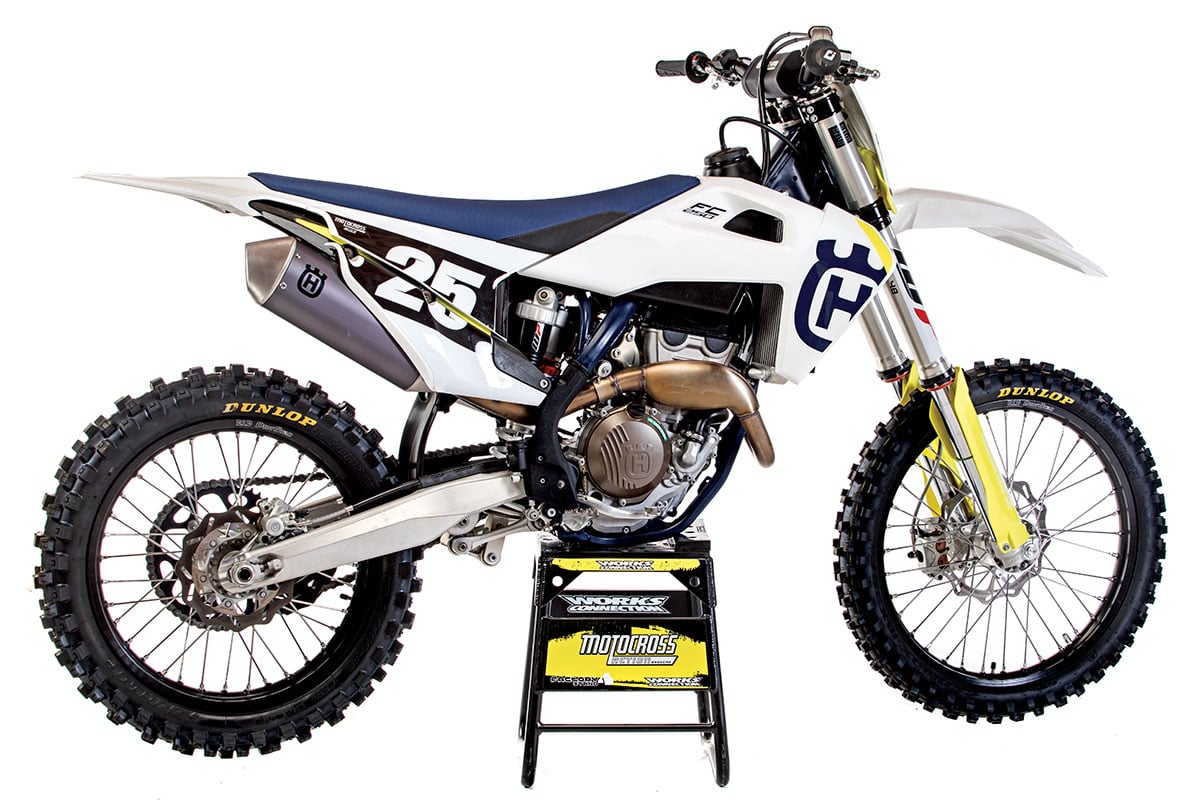 This engine pumps out 42.48 ponies. With the airbox cover removed, it pumps out 44.00.
This engine pumps out 42.48 ponies. With the airbox cover removed, it pumps out 44.00.
(12) Bars. The Husky lineup has an updated Pro Taper bar bend. All testers liked these bars.
(13) Spoke nipples. The D.I.D wheels are laced with new spoke nipples for 2019. The new spoke nipples were supposed to keep the spokes from coming loose. Back to the drawing board, boys.
(14) Transmission. There are no changes to gear ratios or dimensions inside the transmission. The gears themselves are now made by the Formula 1 supplier Pankl Racing systems.
(15) Clamp. The top clamp is 5mm wider, which in conjunction with the stiffer frame and fork settings contributes to a harsher feel.
(16) Throttle body. The Keihin 44mm throttle body has been updated. It offers a new throttle cable mount and a redesigned manifold air pressure sensor.
Q: HOW FAST IS THE FC250 ENGINE?
A: This engine feels very similar to the 2018 engine. That’s because it is the 2018 engine. The major updates are to the exhaust pipe, airbox and electronics. The power curve remains virtually the same, although there are a few small differences. The low-end picks up quicker at initial tip-in, and the midrange has more punch to get to the top-end faster—but we’d like it to rev quicker in the transitions from low to mid. It should be noted that the Husky FC250’s mid-range punch still doesn’t hold a candle to the 2019 YZ250F’s excitement factor. But, to be fair, the YZ250F’s mid-to-top power can’t keep the FC250 in sight as the rpm increase. The 2019 FC250 does its best work at high rpm. No other bike, save for its cousin the 2019 KTM 250SXF, can run with it to its brutally effective 14,000 rpm rev limiter.
 Husqvarna’s engineers left some horsepower on the table with their airbox, but it is fixable at home.
Husqvarna’s engineers left some horsepower on the table with their airbox, but it is fixable at home.
If you want to go fast on an FC250, you have to let it breathe, resist shifting and never pull the reins in. It is a wild stallion on top, but there is a caveat: riding at 14 grand requires talent, skill and bravery. Holding it wide open, never shifting until the engine shrieks and braking late can be intimidating for less-skilled riders, but it’s no secret that Husqvarna and KTM are not catering to 250 Novices. This is a Pro-level engine package. If Husky wanted to make a 250 four-stroke that worked for everyone from Novice to Pro, it would add more midrange power. And while there is top-end power to spare that could be used to pump up the middle, we understand that Husky’s goal is to produce high-performance Pro-level packages, not dumb them down.
Q: DOES THE ENGINE STILL SUFFER FROM HUSQVARNITIS?
A: If you don’t know what Husqvarnitis is, then you haven’t owned a Husky since KTM bought the Swedish brand from the Germans. In comparison to the KTM 250SXF that the Husky FC250 is cloned from, late-model Husky airboxes flow less air to the engine. In fact, Husky airboxes are sealed so tight that they suffocate the Husky engines. Don’t believe us? Take the airbox cover off of your Husky FC250, FC350 or FC450 and ride it for a lap; you’ll notice the difference. The choked-down airbox makes the power build slower and run mellower than it is capable of. Nobody wants a 250 four-stroke that takes its time getting from the bottom to the middle. On the dyno, the stock 2019 Husqvarna FC250 made 42.48 horsepower at peak. When we removed the airbox cover, it made a hair short of 44.00 horsepower. We find it strange that the 2019 airbox was all new from the ground up. Foolish us, we thought Husky was redesigning the airbox to get rid of Husqvarnitis; instead, the engineers made it worse. We think that the 2020 Husqvarna FC250 will have a vented airbox cover —until them you have to vent it yourself.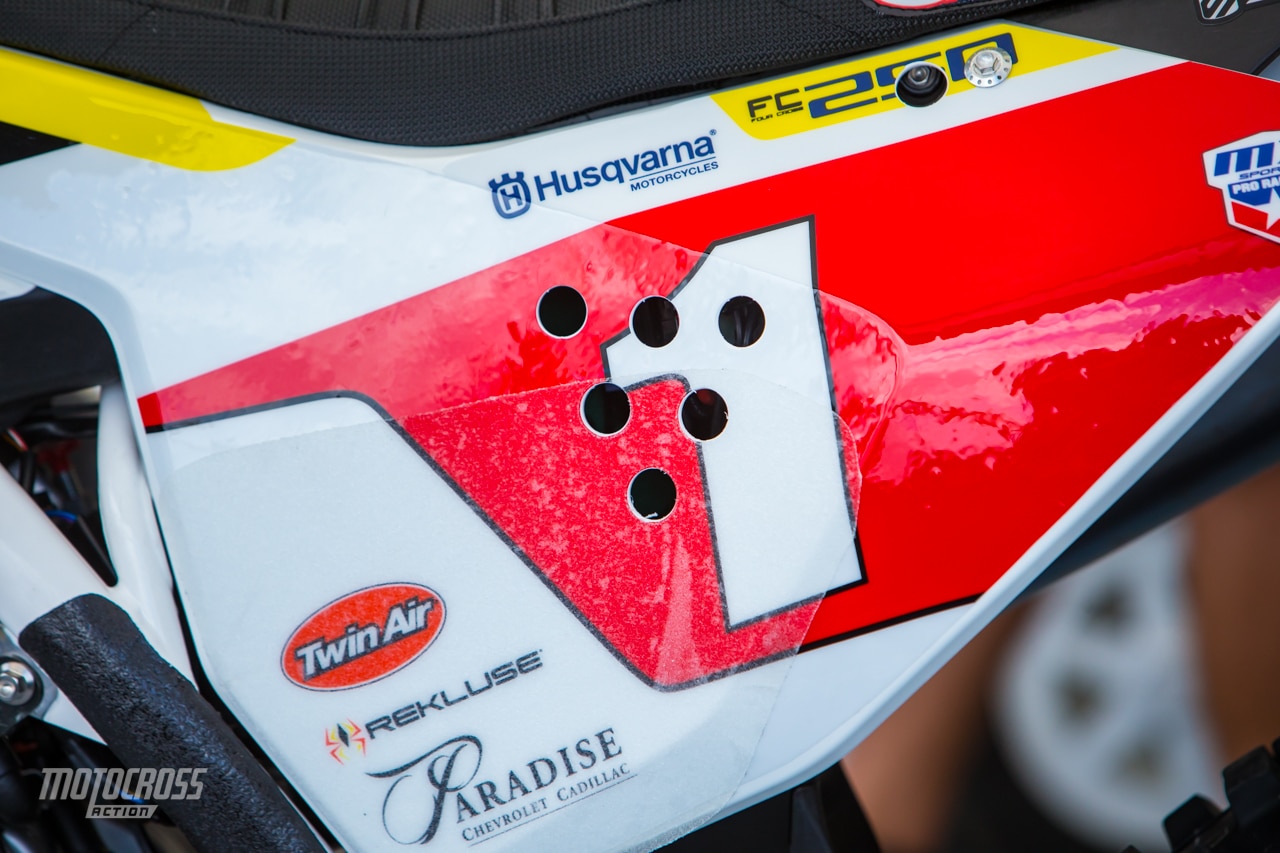 This is how the vent holes holes in the Factory Husqvarna FC250’s are drilled. Note that the holes are drilled behind the air filter proper. They also open up the right side of the airbox.
This is how the vent holes holes in the Factory Husqvarna FC250’s are drilled. Note that the holes are drilled behind the air filter proper. They also open up the right side of the airbox.
We don’t understand what the Husqvarna engineers are trying to prove year after year with this “no air” game plan. Worse yet, we were even more shocked to find out that Husqvarnitis is a contagious disease. For 2019, the KTM lineup caught the same virus! The KTM 250SXF, 350SXF and 450SXF have difficulty catching their breath also.
Before you go drilling holes in the airbox to get free pony power and added low-to-mid grunt, make sure you want more power. Some riders might like the mellower power transition from low to mid. We know many riders who liked the 2019 FC450 power the way it was. If after you ride with the airbox cover off you decided that you like the stock power better, you can put the drill down.
Q: HOW WAS THE GEARING?
A: The gearing isn’t perfect. The box stock 14/51 gearing combo is too tall at a 3.643 ratio. Three years ago, Husqvarna swapped its 13-tooth countershaft for a 14-tooth, which killed acceleration. Most MXA test riders put the 13-tooth countershaft sprocket back on—which delivers a lower 3.923 gear ratio. We did have Pro test riders who could live with the stock gearing after they drilled holes in the airbox, but every Vet was much happier with the 13-tooth countershaft because it delivered a 3.923 gear ratio with a 51-tooth rear sprocket, a 3.846 gear ratio with a 50-tooth rear, and a 3.769 gear ratio with a 49. Those three options are all lower than the stock 14/51 gearing.
Q: WHAT DID WE HATE?
A: The hate list:
(1) Sprocket. Watch the rear sprocket bolts closely. They come loose.
(2) Spokes. Husky said the new spoke nipples would stop the spokes from coming loose. Not true.
(3) Airbox. The best thing about the Husqvarna airbox is that it is mouse proof, dust resistant, water tight and airtight.
(4) Gas hose. The gas hose gets tangled up when taking the gas gap on and off.
(5) Frame. We don’t like the dark blue color and we don’t like the added rigidness of the frame.
(6) Side plates. Two-piece side plates mean two-piece number plate backgrounds and a Grand Canyon gap.
(7) Lock-on grips. We love the ease of use of the ODI lock-on grips. The actual rubber is half as thick as that of glue-on grips. If you have tender hands, swap grips.
(8) Graphics. How much did they pay the designer who threw an “H” at the radiator wings and missed?
 The machined hubs are works of art, but they are really cast hubs that are machined to make them look cleaner.
The machined hubs are works of art, but they are really cast hubs that are machined to make them look cleaner.
Q: WHAT DID WE LIKE?
A: The like list:
(1) Weight. The 2019 Husqvarna weighs 219 pounds, which is a pound more than the KTM 250SXF but 10 pounds lighter than some of its competitors’ 250s.
(2) Brakes. The Brembo brakes with GSK rotors are great.
(3) Air filter. This no-tools airbox makes changing an air filter amazingly simple. We aren’t talking about how well it breathes, just how easy it is to change the filter.
(4) Hydraulic clutch. Having a self-adjusting bulletproof clutch means one less thing you have to think about. The FC250 does not have the Magura seal problems that the FC450 exhibits.
(5) Power. Even though the engine is suffocated down low, it still pumps out serious pony power.
(6) Ergonomics. The FC250 feels like a KTM with a better bar bend.
(7) Suspension. Once you find your personal air pressure setting, the WP AER air forks work for many skill levels and body types.
(8) Levers. We love that riders can easily adjust how far they want the lever in or out.
(9) Hour meter. It is a great touch.
(10) Grips. Paradoxically, since we have hands made of Brillo pads, we like the ODI lock-on grips.
(11) Handling. Almost faultless—save for the person behind the bars. 
Q: WHAT DO WE REALLY THINK?
A: This is the most expensive bike in its class at $9099. For that price, we don’t think Husky should be stealing power from its customers. Maybe it’s just us, but we think it could be better with a more resilient frame, plusher fork valving, a source of air, better gearing and one-piece side number plates. Having said that, this is a machine with many strengths and very few serious weaknesses.
MXA’S 2019 HUSQVARNA FC250 SETUP SPECS
This is how we set up our 2019 Husqvarna FC250 for racing. We offer it as a guide to help you find your own sweet spot.
48MM AER FORK SETTINGS
The stock Husky air fork setting is 149 psi. This is stiff and doesn’t suit the majority of Husky FC250 owners. Most Vet riders tend to run lower pressures than fast riders, often as low as 130 psi. There is no harm in a low air pressure setting, as long as the front of the bike doesn’t hang down in the corners and use up travel too quickly. For hardcore racing, we recommend this fork setup for an average rider on the 2019 Husqvarna FC250 (stock specs are in parentheses):
Spring rate: 136 psi (149 psi)
Compression: 28 clicks out (15 clicks out)
Rebound: 17 clicks out (15 clicks out)
Fork leg height: Third line
Note: If we feel that the forks are harsh in the middle but tend to ride high when we increase the air pressure, we lower the oil height in the damping leg by 10cc to 20cc to eliminate a harsh spot in the travel. Additionally, pay attention to extreme temperature changes. You may have to change the AER’s air pressure as it gets hotter later in the day. We bleed the outer chambers constantly.
WP SHOCK SETTINGS
If you are heavier than 185 pounds, you might have to go up one on the spring rate to a 45 N/m. If you are lighter than 130 pounds, you should look into the 39 N/m spring. Overall, this is a very good shock. Although we do make clicker adjustments, we rarely stray very far from the stock 15 clicks out on compression. It can be dialed in with only a few clicker changes. As a rule of thumb, most MXA test riders leave the low-speed compression on the stock setting and focus on the high-speed dial to make the changes. We do run additional rebound damping. For hard-core racing, we recommend this shock setup for the 2019 Husqvarna FC250 (stock specs are in parentheses):
Spring rate: 42 N/m
Race sag: 105mm
Hi-compression: 2-3/4 turns out (2 turns out)
Lo-compression: 15 clicks out
Rebound: 11 clicks out (15 clicks out)
Notes: We turn the high-speed compression damping out 3/4 of a turn to soak up chop when seated and run more rebound than the recommended setting. ο


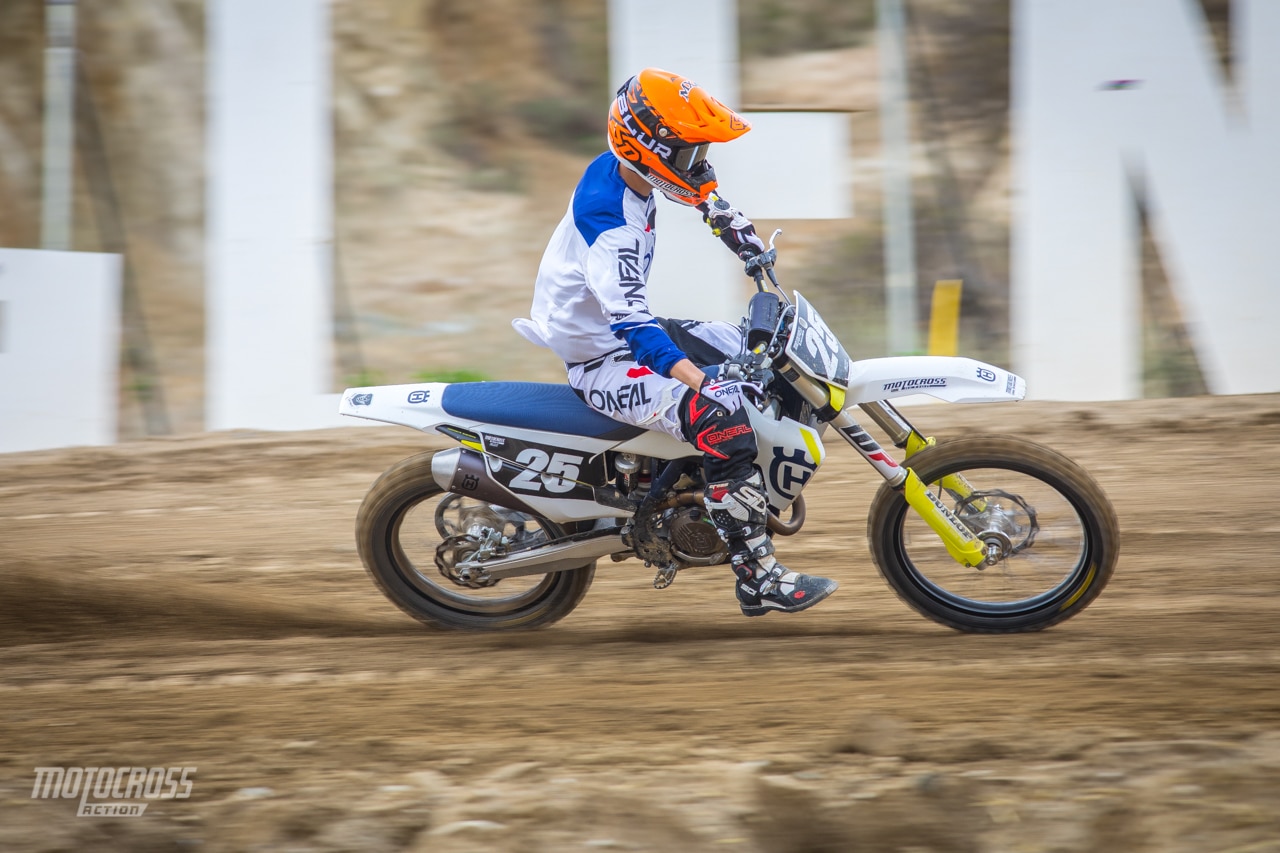
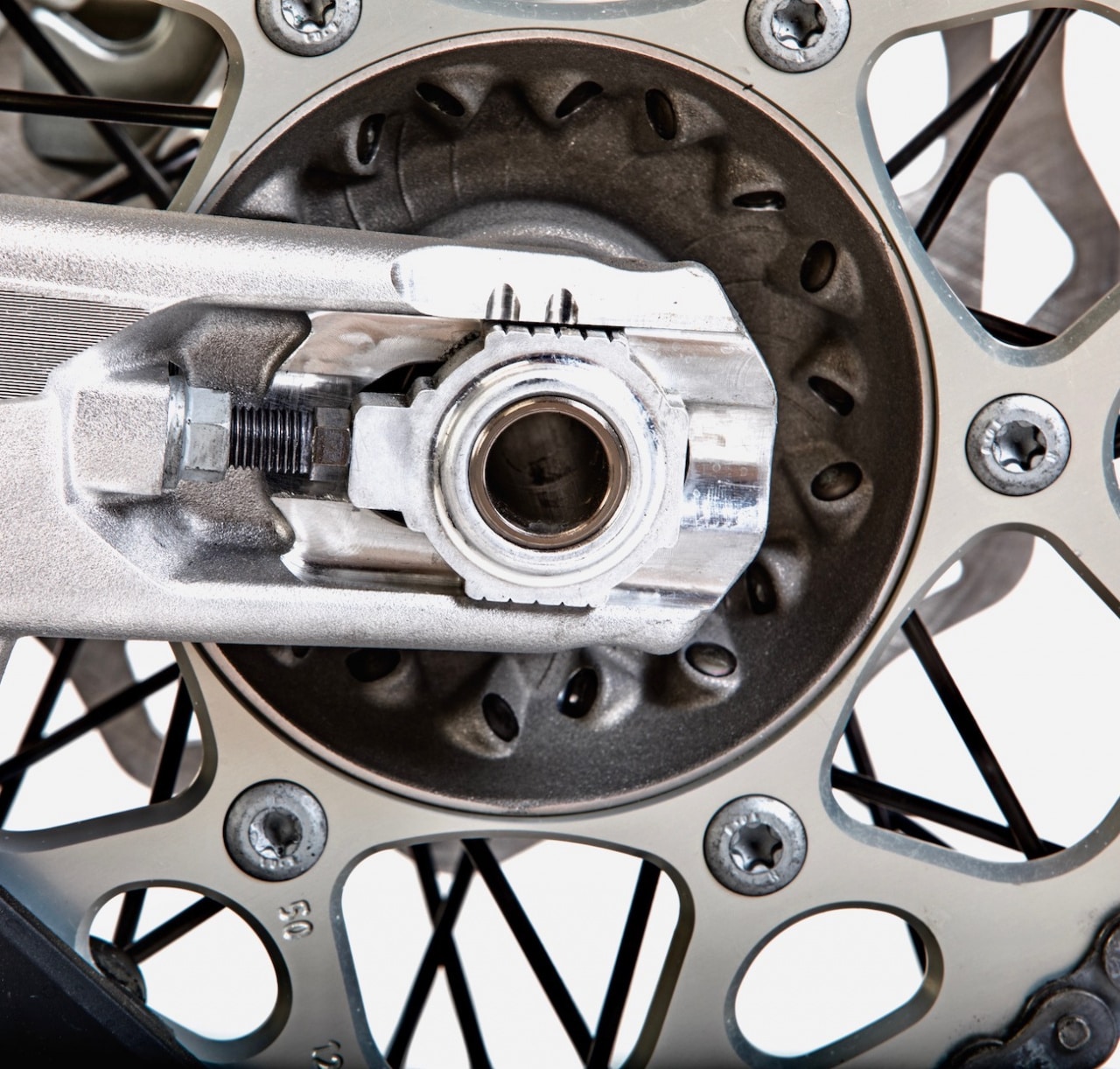
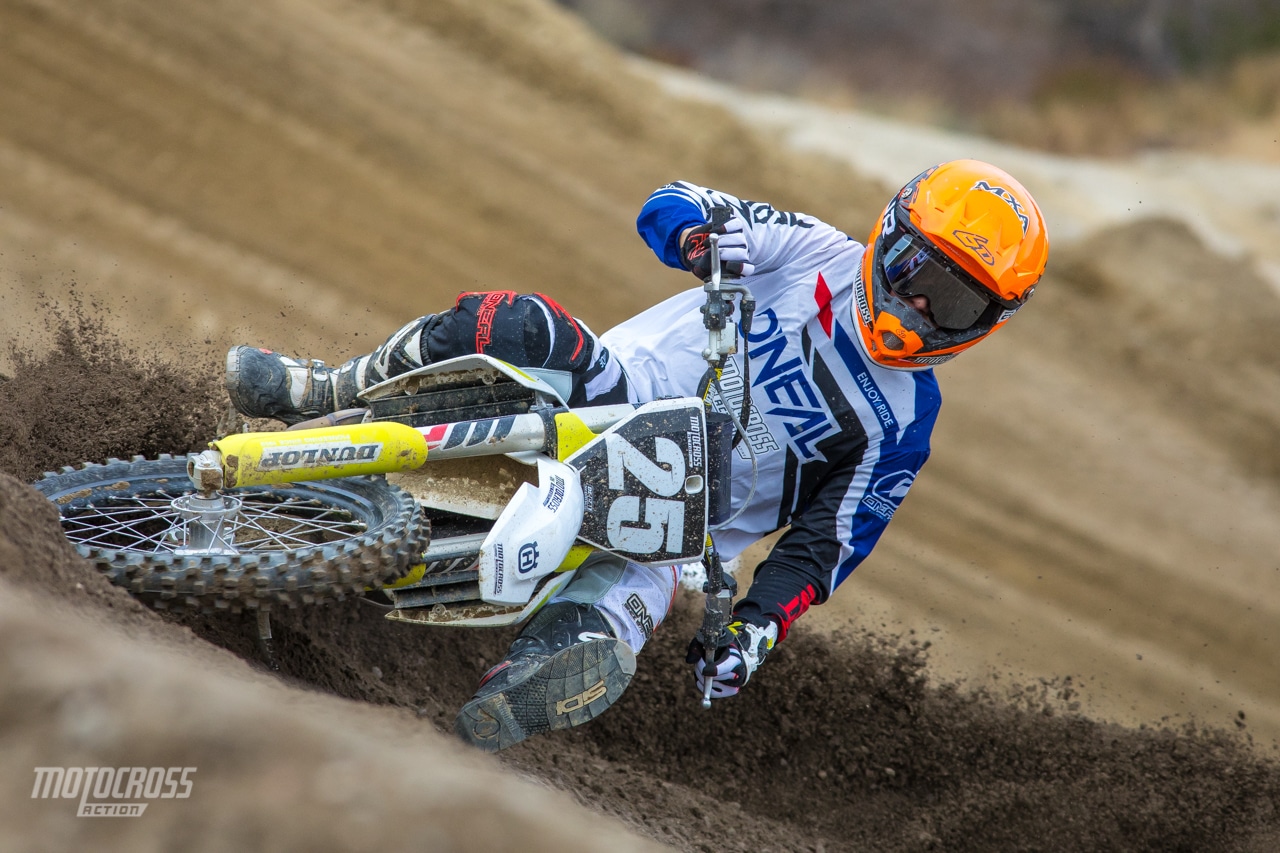
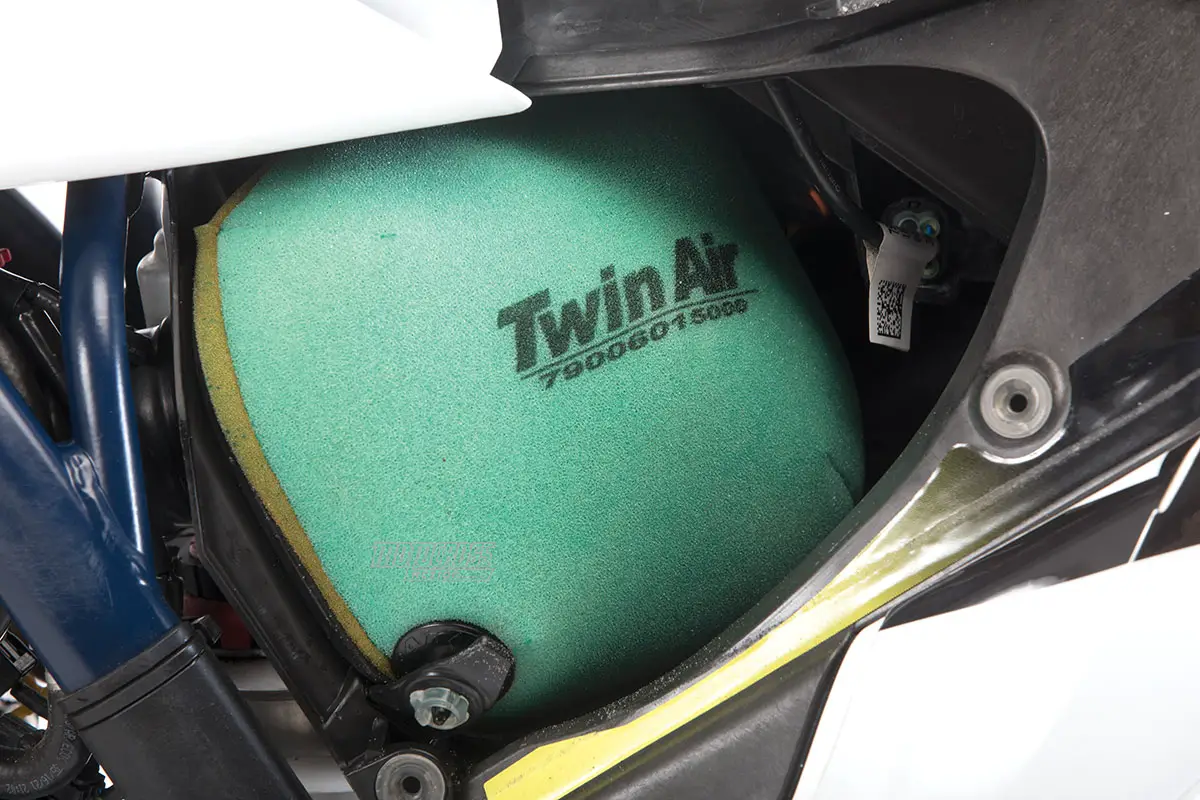

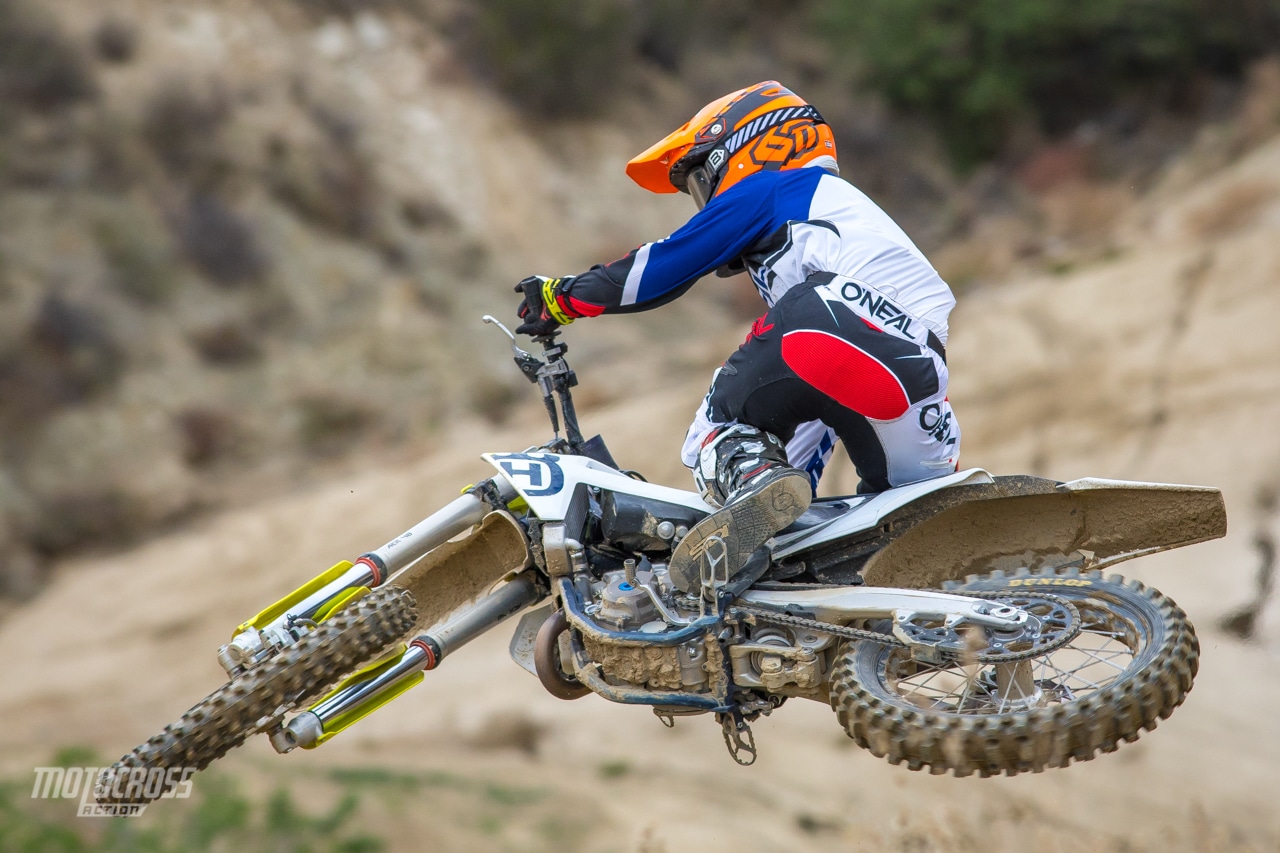
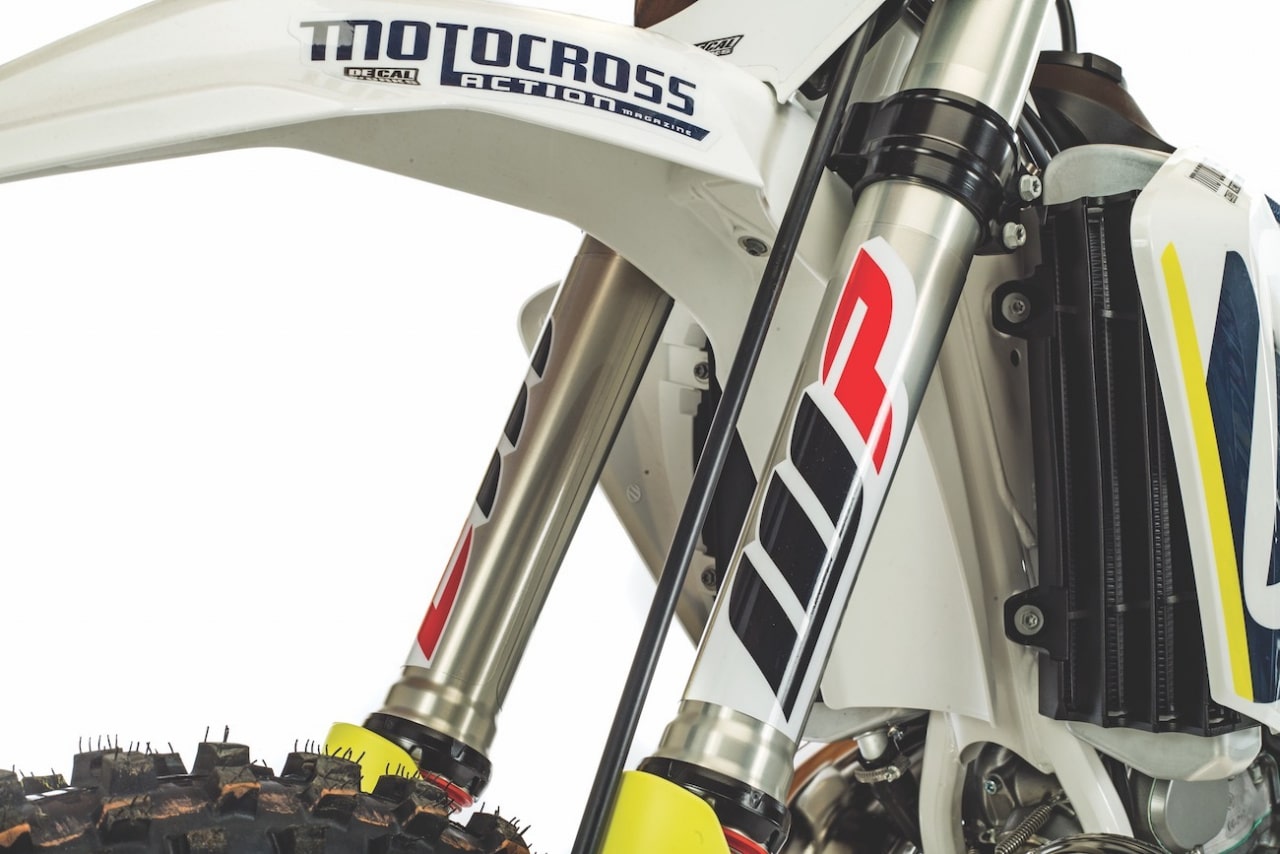
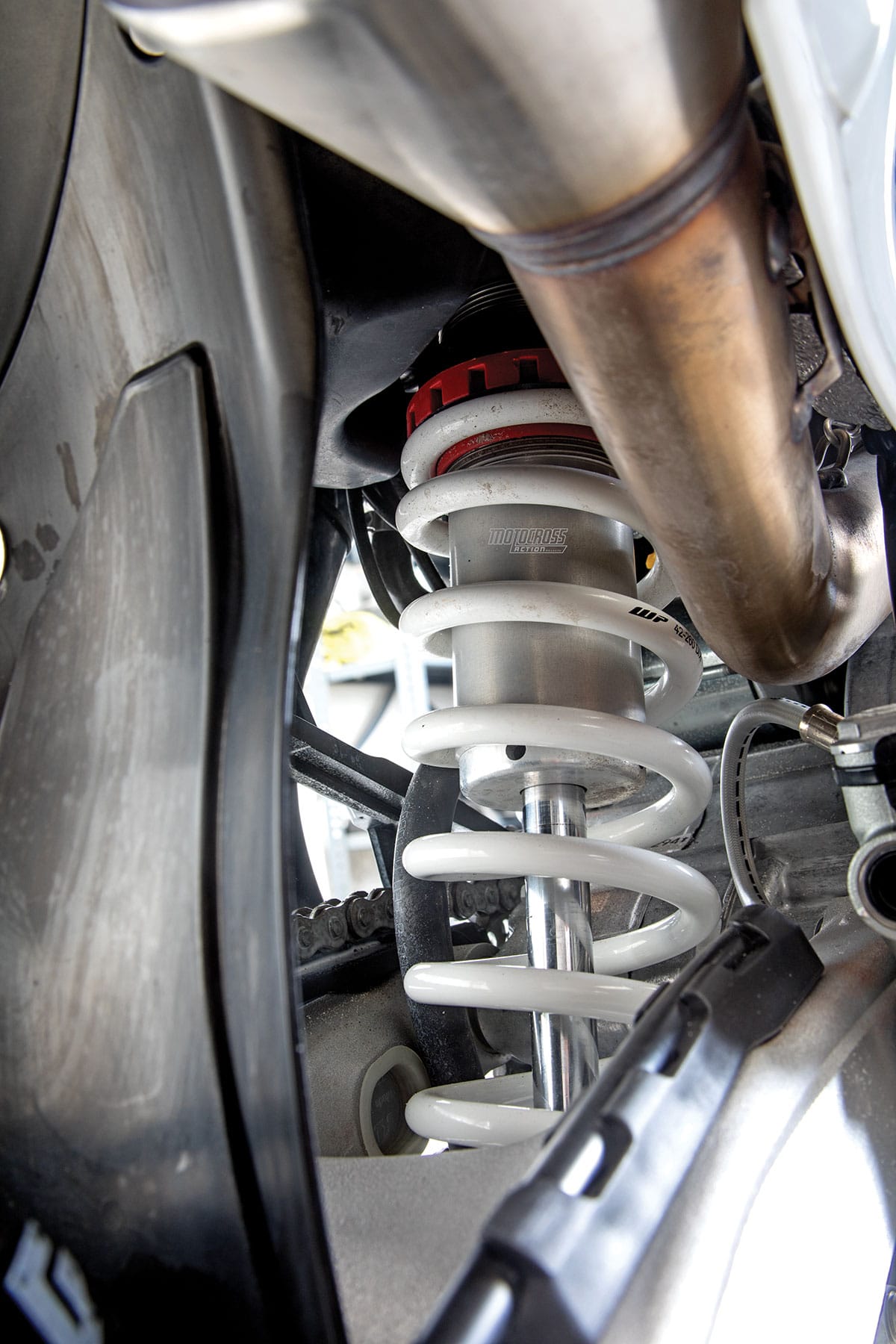



Comments are closed.